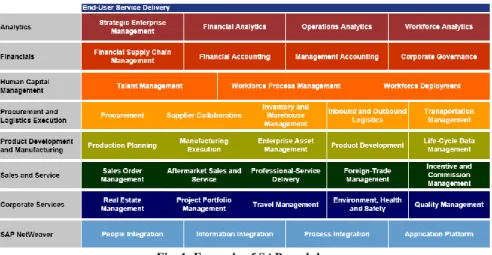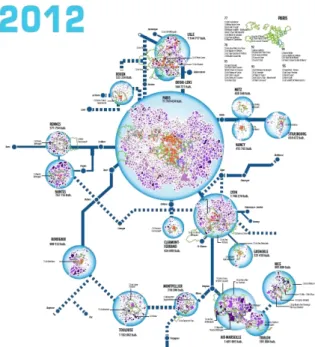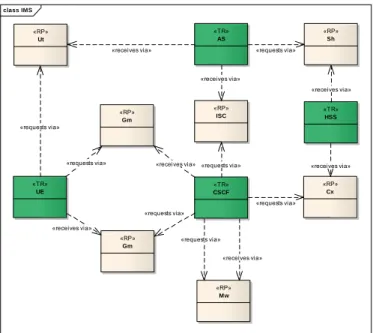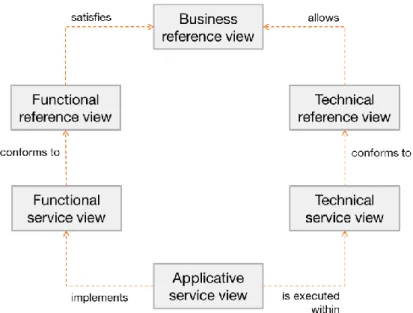HAL Id: hal-01263318
https://hal.archives-ouvertes.fr/hal-01263318
Submitted on 27 Jan 2016
HAL is a multi-disciplinary open access
archive for the deposit and dissemination of
sci-entific research documents, whether they are
pub-lished or not. The documents may come from
teaching and research institutions in France or
abroad, or from public or private research centers.
L’archive ouverte pluridisciplinaire HAL, est
destinée au dépôt et à la diffusion de documents
scientifiques de niveau recherche, publiés ou non,
émanant des établissements d’enseignement et de
recherche français ou étrangers, des laboratoires
publics ou privés.
Urbanization of information systems : an outdated
method?
Emmanuel Bertin, Noel Crespi
To cite this version:
Emmanuel Bertin, Noel Crespi. Urbanization of information systems : an outdated method?. DED&M
2014 : 2nd International Conference on Digital Enterprise Design and Management, Feb 2014, Paris,
France. pp.83 - 91, �10.1007/978-3-319-04313-5_8�. �hal-01263318�
Urbanization of Information Systems: An
outdated method?
Emmanuel Bertin
Orange Labs – 42, rue des Coutures 14000 Caen, France.
Noel Crespi
Institut Mines-Telecom, Telecom SudParis – 91000 Evry, France.
Abstract The urbanization of Information Systems has been a widely employed
method for years. But changes in the organization of enterprises are currently challenging it. Moreover, some of its original assumptions derived from the urban-ization of cities are also questioned. In this context, this article exposes how the urbanization can be renewed by inspiring from the new city planning trends, and move from a function-based urbanization to a flow-based urbanization.
Introduction
The organization of enterprises is changing. The functional structure as promoted by Taylor and Ford at the beginning of the previous century is less and less useful in a fast moving environment, where firms have to compete at the innovation fron-tier- whatever technological, marketing or value chain innovation. In this new context, what become the principles of Information System (IS) urbanization, as recommended during the 90ies?
This paper is investigating this question, by revisiting the initial assumptions of the IS urbanization. In the first section, we remind these initial assumptions and their impact on the IS, but also their underlying source in the city planning. In a second section, we prolong the usual parallel between cities and IS by presenting the recent trends in city planning, as well as possible analogies with the IS. In the third and last section, we proposes a new method to move from a function-based to a flow-based urbanization.
The assumptions of urbanization
Urbanization, in a nutshell
Urbanization mainly consists in three main activities:
cartography of the existing IS
conception of a target IS
determination of a migration path from the existing to the target IS
In other words, according to [1]:
"Urbanization is to organize the gradual and continuous transformation of information system to simplify it, to optimize its added value and to make it more responsive and flexible towards strategic business changes, while relying on technical opportunities of the market. Urban planning defines rules and a coherent, stable and modular context, in which different stakeholders are referring to any investment decision in the Information System."
To achieve these goals, the IS is usually represented with four viewpoints:
the business viewpoint is composed by the processes describing the activities of the whole enterprise (for example fulfillment, assurance or delivery processes)
3
the functional viewpoint is composed by the functions supported by the IS, and that are necessary for the realization of the business processes (and thus for the realization of the enterprise’s activities)
the applicative viewpoint is composed by the software applications of the IS
the technical viewpoint is composed by the infrastructural components support-ing the IS software applications.
To sum-up, the business view responds to the question of ‘why’, the functional view responds to the question of ‘what’, the technical view responds to the ques-tion of ‘with what’ and the applicative view responds to the quesques-tion of ‘how’ [2]. In the reference methodologies, like in the seminal work from Christophe Lon-gépé [3], the most operational viewpoints are usually the functional one and the applicative one. The applicative viewpoint enables indeed to make a detailed de-scription of the existing software programs and data from the IS, and to propose a target. The functional viewpoint is the key tool in order to conceive this target. In-deed, the identification of the main IS functions enables then to make a blueprint map of the IS, in order to position the various applications on it. This leads finally to the definition of a target reference model, where a function is usually imple-mented by one and only one software application (in order to prevent a function to be scattered between various applications).
Functions are thus the key concept of urbanizations methods. Moreover, func-tions are usually split with a hierarchical division: functional zones are divided in-to functional districts that are themselves divided inin-to single functions. The func-tional coherence should be high within a subdivision: a district groups highly coherent functions, and a zone groups highly coherent districts. Implicitly, these fundaments rely on a city planning paradigm.
The metaphor of the city
Usually, city planning is indeed grounded on geographical invariants. A city is divided into zones, quarters and blocks. City planning rules are then enacted and enforced for each area. Obviously, these divisions must be stable in the time, and the stakeholder of the city can therefore consider them as invariant. As detailed in [4], the urbanization of the IS relies similarly on the supposition that stable func-tional blocks can be identified, if not forever at least for a long time. In his first urbanization work for the Société Générale, Jacques Sassoon [5] considered in-deed banking products as the basic units offered by a bank. Similarly, Christophe Longépé [3] defines six functional zones (an exchange zone, a data repository zone, a referential zone for data and rules, a steering zone, an operations zone, a resource zone) in his work.
Let us now discuss how these city planning principles have been applied in real-world towns, and with which consequences. The principles from the Functional City have been defined in 1933 par Le Corbusier, with his famous “Athens char-ter”. The ideal city is composed of blocks, where one block is dedicated to one and only one function. Four functions were identified: to live, to work, to entertain and to move. Human flows can be easily predicted (e.g. from the living block to the working block each morning), and the transportation infrastructures are con-ceived accordingly. The functional zoning enables to plan minimal dependencies between zones.
These theoretical principles have been massively applied to rebuild European towns after the Second World War. The governance of this urbanization process has been characterized by a tight centralization, driven by a strong administrative power (incarnated in France by senior civil servants, like the “ingénieurs des Ponts et Chaussées”). Key decisions were taken at a nation-wide level, without a real adaptation to each territory. The same types of buildings with the same framework have been for example built in Lille, Toulouse or Nancy. A strict regulation has led to a standardization of tools and methods (e.g. masterplans, blueprints). Inhab-itants were not considered as stakeholders, but as resources that should remain stable and accountable.
We have to admit this functional paradigm has been produced mixed results, to say the least. With economical changes, work has disappeared from the working areas, and people from the living areas have suffered from mass unemployment, as the transportation flows have not been design to connect them to other opportuni-ties.
The Functional model for the IS, some consequences
Not only have the main urbanization methods followed the Functional paradigm, but the ERP tools also have. For example, figure 1 indicates some SAP modules that can be deployed in a firm. A Functional cutting can be easily noticed.
Within this paradigm, the governance of the IS tends to be centralized, as for cit-ies. Ex-ante validation committees are involved to enforce the rules, and each IS project should be so validated. Transversal enterprise architects are dedicated to plan the evolution of the IS, and are natural members of the validation commit-tees. Chief architects are here in a most powerful position than project owners. Moreover, the paradigm is usually linked with a Functional organization of the firm, which is also divided into functions, like commercial function, production, R&D, finance…
5
Fig. 1. Example of SAP modules
However, like for the cities, the strict enforcement of a Functional paradigm has obviously some drawbacks:
First, the business of the firm can be rapidly evolving due to commercial, eco-nomical or technological disruptions. If this was still not fully the case in the 90ies, we now live at a time of uncertainty and unpredictability. Identifying in-variant rules becomes a challenge. Enforcing they strictly might become a handicap in the worldwide competition.
Second, a Functional model is hardly adaptable. A functional model structured by invariants will typically evolve less rapidly than the business environment. Innovative applications can be positioned on the existing functions only with difficulties or contortions.
Third, the Functional paradigm tend to a coupling between the IS and the or-ganization of the firm. In enterprises following this urbanization paradigm, the organizational structure is often inspired by the division in functional zones. This can slow down the decision making, due to necessary trade-offs between functions.
Fourth, the end-user is not directly taken into account in the Functional para-digm, whatever internal end-users (i.e. employees) or external ones (i.e. cli-ents). A single end-user need will typically necessitate the execution of many applications, from various functional zones, to be fulfilled. However, depend-encies between applications are not directly represented on the Functional map, as well as potential incompatibilities. An end-to-end vision of the fulfillment of end-user requests is sometimes lacking.
The limitations of the Functional paradigm finally seem more or less similar con-cerning the cities and the IS. This statement encourages us to review the topical urbanization paradigm of the nowadays city.
A new urbanization paradigm, the multipolar city
Concerning city planning, the Functional paradigm has outlived its time. A city is no more conceived as a juxtaposition of different functional zones, but as a hub to enable the circulation of flows. The idea is to recreate some continuity between the various functions. Each area is intended to be multifunctional, by grouping for example housing, offices and commercial or entertainment activities. The aim is to attract the people that are also multidimensional: working in transportation, doing sport in the middle of their working day, or shopping just in front of their office after work. The gist of the multipolar paradigm can be summed up in one sen-tence: flows should prevail over premises. The hub and spoke paradigm is thus a key concept: as well financial then human flows are running from hubs to hubs, without stopping at middle places. A new urban fabric will emerge around these hubs, mixing offices, housing and multiplex entertainment centers. Transportation infrastructures become then a key tool for the Multipolar paradigm: for example roads, trains or planes between cities, the tramway for suburbs. Figure 2 illustrates this by representing the connections between main French cities.
Fig. 2. Hub and spoke view of the main French cities
The governance is now decentralized, but with an indirect centralized but remote control, for example via founding agencies promoting a common vision through calls for project proposal, or via the financing of infrastructures (e.g. transporta-tion infrastructures, but also museums, public centers, etc.). The aim is to
empow-7
er the actors of the town (local and regional elected officials, architect…), while guiding them toward a centrally-decided direction.
We believe that this new urban paradigm can also serve as a metaphor for the IS. This would mean multi-functional zoning, ex-post validation, tools to manage the intensification of the flows, etc. In particular, transposing this new paradigm to the IS would mean to conceive the IS as a system to manage flows, instead than a sys-tem to manage data. The key stakes are thus the following:
The delivery of the flows, how to orient them, how to manage access rights, how to communicate between applications?
How to represent the flows in an end-to-end way and to control them?
How to take into account the end-user, as a source of flow as well as an actor to treat them?
How to more dynamically adapt the IS to the business evolutions?
This model is still not generally applied, but it echoes issues currently raised by enterprises [6]. It is also aligned with the recent proposals to modify enterprise ar-chitecture concepts, like in the works from Pierre Pezziardi [7].
From a function-based to a flow-based urbanization
Let us now study how this flow-based urbanization could be achieved. The foun-dations would be the following ones.
First, business processes are a key element, underexploited in the classical Func-tional paradigm.
They provide a dynamic view of the enterprise business.
They can easily adapt to the changes in the business activities.
The end-user can be integrated as an actor, that not only triggers activities but that can also be involved in their realization.
They enable to identify the business data manipulated by the different actors from the IS
Finally, they are easily shareable within the enterprise (architects, business owners, employees…)
Second, technological patterns enable to represent the infrastructure that supports the flows in the IS.
They present a relational view of the technological solutions used in the enter-prise
They are independent of the realized functions
Two technological patterns are for example represented in figures 3 and figure 4: the IMS (IP Multimedia Subsystem) pattern – coming from the telecom world, and the SOA pattern (Service Oriented Architecture) – coming from the IT world.
Fig. 3. The IMS technological pattern
Fig. 4. The SOA technological pattern
Third, a new correlation between the business and the technological view is still to invent. class IMS «TR» UE «TR» CSCF «TR» AS «RP» Gm «RP» ISC «TR» HSS «RP» Ut «RP» Cx «RP» Sh «RP» Mw «RP» Gm «receives via» «receives via» «requests via» «receives via» «receives via» «requests via» «receives via» «requests via» «requests via» «requests via» «receives via» «receives via» «requests via» «requests via» class SOA «RP» bind «TR» WSP «TR» WSC «TR» WSD «RP» publish «RP» find
«receives via» «receives via»
«requests via»
«receives via» «requests via»
9
To represent how each business need give rise to applicative flows
To represent how each application is transforming and retargeting them
This flow-based urbanization relies on the distinction between reference views and architecture views. Reference views are stable during the lifecycle of an ap-plication, whether service views are dedicated to a given project (c.f. figure 5). The reference business view describes the business processes of a firm. The functional reference view formalizes the information coming from the business processes. The technical view describes the technological patterns used in the firm.
The functional service view formalizes the functional perimeter of a given pro-ject. The service technical view describes what technical components are used within this project. And the service applicative view details how the information flows (coming from the service functional view) are running in an end-to-end manner through the components coming from the technical view.
Conclusion
Enterprises are now living in a fast changing business environment, subject to commercial, financial and technical evolutions that can occurs in only one or two years. Agility becomes thus a cardinal virtue. The organization of the firm should be adapted to this, and so does the urbanization of the IS. The new urban Multipo-lar paradigm provides an interesting metaphor to help us moving from a function-based static urbanization to a flow-function-based dynamic one.
The key stake is here to take into account the various flows passing trough the IS – to understand them by describing them, in order to still master the end-to-end functioning of the IS at a time of uncertainty. The principles introduced in this ar-ticle are further detailed in [8] and [9].
References
[1] http://www.urba-ea.org/
[2] SIMONIN J., BERTIN E., LE TRAON Y., JEZEQUEL J.M., CRESPI N., “Business and in-formation system alignment: a formal solution for telecom services”, proceedings of ICSEA 2010 : The Fifth International Conference on Software Engineering Advances, CPS, 22-27 August 2010, Nice, France, 2010, pp. 278-283.
[3] LONGEPE C., The Enterprise Architecture IT Project: The Urbanisation Paradigm, Butter-worth-Heinemann, Oxford, 2003.
[4] CONTINI I., “L'apport historique de l'urbanisme des villes pour l'urbanisme des systèmes d'information”, Colloque Urbanisation des Systèmes d'Information, Paris, 2002.
[5] SASSOON J., Urbanisation des systèmes d'information, Hermès, Paris, 1998.
[6] BIDAN M., ROWE F. et TRUEX, D., “An empirical study of IS architectures in French SMEs: Integration approaches”, European Journal of Information Systems, 21, p. 287-302, 2012.
[7] PEZZIARDI P., Lean Management : Mieux, plus vite, avec les mêmes personnes, Eyrolles, Paris, 2010.
[8] BERTIN E., CRESPI N., Architecture et gouvernance des services de communication, Her-mès Lavoisier, Paris, 2013.
[9] BERTIN E., CRESPI N., Architecture and Governance for Communication Services, Wiley ISTE, London, 2013.



